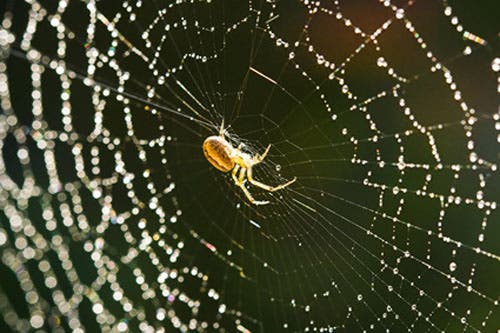Graphene – the one atom thick sheet of carbon arranged in a hexagon lattice – is the strongest material known to man, and spider silk is one of the strongest found in nature, second only to limpet teeth. Heck, why not combine the two? Sounds silly, but it surprisingly worked when Nicola Pugno of the University of Trento, Italy sprayed spiders with both graphene particles and carbon nanotubes. The spiders weaved silk infused with the materials, and in some cases the silk was 3.5 times stronger than its natural counterpart. The resulting fiber is tougher than “synthetic polymeric high performance fibers (e.g. Kevlar49) and even the current toughest knotted fibers,” according to the paper published in Materials Science, which obviously entails a lot of real-life applications, industrial or otherwise.

Pugno and colleagues first collected some 15 Pholcidae spiders, which are fairly common in the Italian countryside and kept some of the woven fibers for reference. They then simply sprayed the spiders’ bodies with a solution containing a mixture of water and graphene particles 200 to 300 nanometres wide. Another group of spiders was sprayed with a solution that contained carbon nanotubes – carbon atoms linked in hexagonal shapes, with each carbon atom covalently bonded to three other carbon atoms. Although, like buckyballs, carbon nanotubes are strong, they are not brittle. They can be bent, and when released, they will spring back to their original shape.
Some of the resulting spider silk was flimsy and failed, but some spiders managed to weave a reinforced web that was incredibly strong. The researchers measured the properties of the silk by placing the fibers between two C-shaped holders, then again inside a special device that subjected the fibers to mechanical load.
“We measure a fracture strength up to 5.4 GPa, a Young’s modulus up to 47.8 GPa, and a toughness modulus up to 2.1 GPa,” the researchers explain. “This is the highest toughness modulus for a fibre,” they add.
On one occasion, the woven fiber was 3.5 times stronger than the strongest spire web measured in the world, spun by the giant riverine orb spider. It’s not clear though how the materials ended up in the web to reinforce it. Pugno and team believes the spiders soaked up the graphene and nanotubes and incorporated them into their silk when it was spun.
Spider silk is definitely something the industry is keeping its eye on. Three times stronger than steel and three times tougher than Kevlar, synthetic spider silk could find its way in a number of applications, from automotive, to military, to civil engineering. It might also prove to be the ultimate band aid. Last year, a new synthetic spider silk manufacturer was opened, a sign that spider silk is moving into a commercial territory fast.
Was this helpful?



